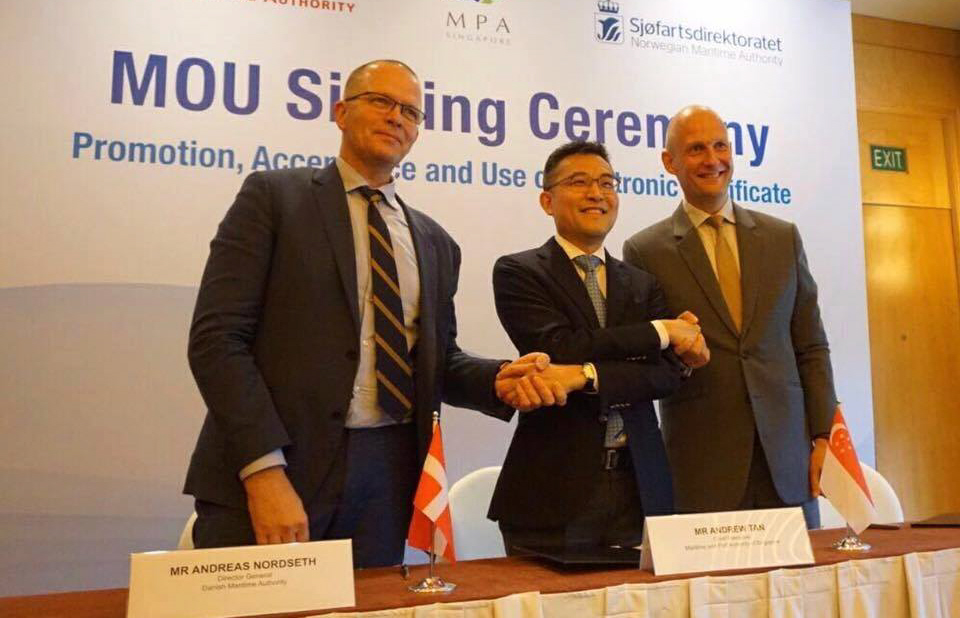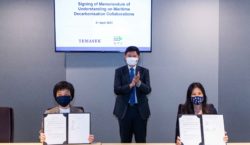On 24 April 2017 the Danish Maritime Authority (DMA) together with the Norwegian Maritime Authority (Sjøfartsdirektoratet), and Maritime and Port Authority of Singapore – MPA signed a Memorandum of Understanding.

The MoU promotes the adoption of E-Certificates (E-Certs) for the shipping community as part of move to digitalise the shipping industry for greater efficiencies.
This is believed to be the first MoU anywhere in the world between the maritime authorities of European nations and an Asian country that promotes the acceptance and use of E-Certs over hard copy documents practised by the shipping community today.
The MoU was signed by Mr Andreas Nordseth, Director General of the Danish Maritime Authority; Mr Andrew Tan, Chief Executive of MPA; and His Excellency Tormod C. Endresen, Norwegian Ambassador to Singapore on behalf of the Norwegian Maritime Authority. The signing ceremony was done at the sidelines of the Singapore Maritime Week, the leading maritime event which gathers the international maritime community in Singapore for a week of conferences, dialogues, exhibitions and social events in celebration of all things maritime.
The areas of cooperation under the MOU include the promotion and use of E-Certs on ships registered under the respective flags of the parties, the acceptance of E-Certs for port entry and Port State Control inspections, as well as the sharing of information and experiences relating to issuance, use and acceptance of E-Certs.

The shipping business is traditionally a paper-intensive industry. Hard copies of over two dozen certificates such as Certificate of Registry, Certificate of Class and Load Line Certificates, among others, are kept on board ships to provide proof that the vessels are compliant with the various regulations or conventions applicable to them.
The heavy reliance on hardcopy certificates means that stakeholders such as flag administrations, classification societies, seafarers and shipowners, have to incur considerable manpower and financial commitments in the preparation, printing and delivery of these certificates. In recent years, new technologies and increasing digitalisation have impacted our lives and business operations and the shipping industry is no exception. Converting the hardcopy certificates to E-Certs is part of the digitalisation movement to reduce these administrative burdens in the shipping industry.
“Through such initiatives as e-certification, Singapore seeks to harness the growing importance of Information and Communications Technology (ICT) to prepare the maritime sector for a digital future. We look forward to working with more partners to promote the use of technology in the industry. The time is ripe for this. I am glad that Denmark, Norway and Singapore have led the way to show the potential of harnessing ICT to improve administrative efficiency while reducing costs for the benefit of the industry,” said Mr Andrew Tan, Chief Executive of MPA.
His Excellency Tormod C. Endresen, Norwegian Ambassador to Singapore said: “The time is now ripe to pursue the rewards which can be realised by the prospects of extending the use of and capitalise on the information technology in the maritime shipping industry.”
According to Mr Andreas Nordseth, Director General of the Danish Maritime Authority there is still more to do before the maritime world can truly reap the benefits of digitalisation. He said, “Our first target is to inspire and support more countries to implement similar solutions. The reduction of paperwork benefits all stakeholders as it makes the entire maritime sector more efficient. We hold high hopes that the MoU signed today will encourage many countries to complete a similar transition.”



